Premium crisps are thriving as consumers continue to seek out affordable treats – but their success has come at the expense of impulse sales, says Noli Dinkovski
The recession certainly wasn't crunch time for crisps not at the premium end of the spectrum anyway.
With more people than ever entertaining at home rather than eating out at expensive restaurants or going to the pub, premium crisps and larger sharing formats thrived.
And buoyed by NPD such as Walkers' Red Sky, launched early last year; United Biscuits' recreation of the Phileas Fogg brand; and Kettle Chips' recent move into ridged crisps, they continue to outperform the sector now the economy is picking up.
But their success appears to have come very much at the expense of the impulse sector. While IRI credits the 3.1% rise to £2.4bn in the value of the overall crisps, nuts & snacks category largely to premiumisation, it attributes the 0.6% dip in volume to underperformances from standard crisps, baked snacks and impulse lines [52w/e 20 March]. Niche categories such as pretzels (up 4.9% value, 9.2% volume) and tortillas (up 12.2% value, 7.6% volume) have experienced large gains, while standard crisps have climbed just 1% in value and dropped 0.5% in volume. Indeed, impulse volume sales have tumbled 4.5% (0.9% in the major multiples).
Conversely, Kantar data, which measures only the take-home market (effectively stripping out impulse sales), shows sales of multipack crisps up 5.7%, multipack snacks 6.5% and sharing bags up 8.4% [52w/e 21 February]. Instead of measuring a dip in volume, it measures an increase of 1.1% (and a larger value increase, of 5.8%) further evidence shoppers are eschewing the relative expense of impulse items for the perceived affordability of supermarket offerings.
The sector hasn't been helped by a number of the major retailers cutting back on promotions in the category (see box p74). But the real problem appears to be a consumer move from single-serve packs to better value for money multi or large packs, coupled with problems within the impulse channel itself. Kantar believes there has been a significant shift away from independents to the supermarkets.
One of the key reasons premium snacks are doing so well is that they benefit from the so-called 'lipstick effect' whereby consumers look for cheap luxuries when times are hard, claims Ben Harris, business development director at design agency Anthem Worldwide. Anthem recently created the branding and packaging for Warburtons' new snack brands, ChippidyDooDaa and SnackaDoodle (see box p69), which Harris says meet growing consumer demand for a broader premium range.
"The premium crisps sector has moved on from being an emergent sector created originally by then niche brand pioneers such as Kettle and Tyrrells, to a diverse and complex category in its own right," he says. "It has reached the critical mass of market share and value now for larger players within the crisps and snack sector, as well as from other categories, to be willing to invest in the innovation and marketing spend required to enter the market."
There is no better example of a larger player investing in the premium market than Walkers launching Red Sky early last year. Worth £14.8m, Red Sky still has some way to go before it matches Kettle Chips, which had sales of £82.4m in the past year, but the brand is growing fast [IRI 52w/e 17 April]. The downside is that it seems to have cannibalised sales of its Walkers stablemate Sensations, which has slumped 18.4% in value.
Despite the underperformance of Sensations and a 2.1% slip in sales of the company's core Walkers Crisps brand Walkers marketing director Miranda Sambles stresses that, overall, Walkers has benefited from the dovetailing of the premium and sharing trends.
"The recession has meant people have spent more time at home, boosting the market for sharing occasions," she says. "This ties in with premiumisation as consumers generally trade up in those situations."
Her assertion that sharing bags are becoming more popular would certainly seem to be substantiated by the 19% increase in sales of Doritos (though heavy promotional activity hasn't done it any harm). Single-serve impulse packs, on the other hand, have had a torrid time of it over the past year.
The reason isn't so much that consumers have abandoned impulse purchases, believes Mark Sugden, director of market strategy and planning at United Biscuits, it's that there has been a shift in purchase behaviour towards "planned impulse" consumption. "Those who like to have crisps with their lunchtime sandwiches are pre-buying multipacks instead of buying on impulse. With the economic climate the way it is, it's hardly unexpected."
Standard lines aren't the only ones benefiting from the trend towards multipacks.Premium crisp makers are too Burts Chips being one. Director Jonty White says his company has experienced "huge growth" in multipacks, a format they moved into in 2008.
The increasing popularity of the multipack has played to the multiples' advantage.
Morrisons reports 11.5% growth in its sales of crisps, nuts and bagged snacks, the Co-op 15.3% and Waitrose 15.5% [Kantar], while the independents' and symbol groups' share has been diminishing.
"The market grew in all major retailers and most remarkably in Morrisons, Co-op and Waitrose, which is in line with their total store performance," says Kantar Worldpanel analyst Elena Museva. "Although losing share in total grocery, the discounters have grown share too market share for Lidl increased to 2.5%."
Sugden acknowledges consumers are buying more from supermarkets, but believes there is still a huge opportunity for independents. "Stocking sharing bags and multipacks, and not just single-serves, would be a good place to start," he says.
UB has invested in a £1m research project to help better understand and grow the entire snacking category. In recognising a £540m opportunity currently being lost to retailers, Project Horizon identifies six main groups of snacking consumers: everyday; sharing; treat; break-time; refuel; and healthier options. A key finding of the report is the importance of offering a more inspiring store experience, based on these types.
"However large or small a store may be, a retailer standing in front of a fixture needs to be clear of the snacking needs their products meet," says Sugden.
"That way, they can start to lay out the fixtures in a much simpler way, helping both them and the consumer. From there, the poorest-performing SKUs can be easily identified and the fixture refreshed with new products."
UB works with individual retailers to test and develop alternative fixture layouts. "This works right down to a promotional and tactical level as well. We provide, for instance, pre-filled promotional display units for front of store," says Sugden.
Retailers also need to understand the importance of seasonality in the sector, he adds. The World Cup will be really important to the category. "Savoury snacks grew 34% during the period of the last World Cup in 2006. It's these sorts of spikes in activity that retailers should be prepared for."
Like UB, PepsiCo works closely with retailers and invests heavily in branded display kits to help the impulse channel. While supporting impulse is clearly vital, Sambles believes quality of product is key. "It's about creating great-tasting products that the consumer feels are worth paying for. To them, that's what value is about, irrespective of the economic environment."
And sharing and premium aren't the only tickets to success, as the phenomenal 33.6% increase in Monster Munch sales demonstrates. A retro revamp in late 2008 has completely revitalised the brand's fortunes, turning around the previous sales decline.
Renovation can be just as potent as out-and-out NPD. The secret is to think about innovation in the round, says Sambles. "It's innovation around products, but also innovation around marketing programmes," she says. "Initiatives like Gary's Great Trips, Do Us A Flavour, and now The Flavour Cup are all instrumental in maintaining Walkers' number one position."
Kettle Chips also stresses the importance of continuing to innovate in a downturn. It recently introduced improved versions of three flavours in its range sweet chilli, sour cream & onion and smoky barbecue (formerly honey barbecue) in April and claims its new Ridge crisps, available in sharing-sized bags and aimed at a slightly younger audience than the core brand, has received positive consumer feedback since initial launch in Tesco in February.
UB hasn't stood idly by. It relaunched its premium crisp and snack brand, Phileas Fogg, in April, introducing a new-look pack and updating the flavours to meet demand for more "authentic" tastes and flavours. It is too early to gauge the impact on sales of the revamp, which was supported by a £2m TV campaign. But the range, which includes nuts and poppadoms as well as crisps, has already hit sales of £12.1m [IRI 52w/e 17 April].
However, innovation alone is not enough, says Sugden. "Last year, NPD was £123m that's just 5% of the total value of the category," he says. "Retailers need to focus significantly on making sure the base offering is right as well."
Health
This is something Walkers has struggled to do and its core range is not the only area in which it has had problems. Baked bagged snack sales have slipped 1.4% in value and 3.4% in volume over the past year [IRI] and the underperformance of Walkers Baked is seen as one of the main factors. Worth £35.4m, the brand has lost distribution and fallen by 5.4% in value and 7.7% in volume [IRI]. As of 20 March, there were 4.4 Walkers Baked SKUs stocked in the average major multiple compared with 5.9 at the same time last year.
Sambles blames a dearth of advertising support. "Last year, Baked wasn't advertised, that's why you saw declines," she says. "It just goes to show how engaging advertising, plus the right in-store focus, from customers can make a difference."
PepsiCo has ramped up support for the brand in recent months, with TV advertising and more promotions, a strategy that seems to be working: volumes were up 5.5% in the 12 weeks to 17 April. But some experts are sceptical about Baked's long-term growth prospects and suggest Walkers' reformulation of its core brands which has included a reduction in satfats and switch to SunSeed oil three years ago has cannibalised its Baked sales.
Sambles is adamant there's a future for both. "While they both provide great taste, there is still a clear differentiation between Walkers Baked and the core brand. Baked is for consumers looking for overall benefits, fat being one example. Each bag has little more than 100 calories."
Time will tell whether her confidence is well founded. But what is not in doubt is the great strides the big two manufacturers in the crisps, nuts and snacks category have made in reformulating their core brands to date and both remain committed to making their products healthier. In March, PepsiCo announced a 10-year pledge to focus future profit and growth on healthier products.
It has set a target for half of all its savoury snacks to be baked or include "positive nutrition" (ie fruit, fibre, wholegrain or veg) by 2015. The other 50% of its savoury snacks will be subject to a cap of 160 calories per single serve. Hitting these targets will require "significant changes" to the PepsiCo snack portfolio.
UB has also reformulated significantly across its range reducing satfat content in McCoy's by 30% in 2009, for instance. This was followed by another 30% reduction early this year.
Sugden concedes that continued reformulation is technically challenging, but argues that demand for baked snacks continues even if baked crisps are struggling. "It's no easy thing to ensure you can make a product that consumers will still love, but baked as a method for producing snacks isn't necessarily in decline at all," he says. "I only have to point you to Mini Cheddars." Sales of Mini Cheddars are up 3.2% in value to £53.7m [IRI 52w/e 17 April].
Of course, healthier snacks are not the sole preserve of the big players. Smaller, niche producers have also been working hard to gain greater market share. Crips, the oven-baked part-potato, part-wheat crisp brand, will be trialled in two multiples this summer.
"There's a great deal of opportunity out there as people move slowly away from fried to baked," says Crips MD Gareth Smith. "The fact Walkers and UB are taking measures to make products healthier is really encouraging. It shows we are going in the right direction. The key to a good snack is to make something that is better for you but still feels like a treat."
Healthier crisps have come a long way, but when it comes to nuts, product reformulation has its limitations. However, Sun Valley's recent relaunch of its Nature range under the You Are What You Eat TV show branding demonstrates that the nut category can still play the health card. The four-strong range features a different mix of nuts, exotic fruits and chocolates in new, vibrant packaging.
"Previously, the You Are What You Eat brand was all about preaching healthy information, but consumers don't want to be preached to any more," says Sun Valley marketing manager Jonathan Barr. "These days, they first want to know about taste and quality. I think this is a consequence of manufacturers making healthier products at the cost of taste, flavour and quality."
Despite each pack containing only 200 calories, the calorie-count stays on the rear of the pack, leaving a 5-a-day logo to take pride of place on the front. "Consumers have told us a 5-a-day logo is far more important than the calorific value. If you asked the average consumer how many calories they should be taking in a day, I can guarantee only one in five would know."
Commodity prices
While the jury is still out on the impact of calorie-marked packs, the impact of volatile commodity prices on the sector is clear. In 2008, rising commodity costs of potatoes and oil forced retail prices up, but have since fallen.
In fact, the commodity price of potatoes has tumbled in recent months. The average price has fallen 16.1% to £107 per tonne year-on-year [The Grocer 33 w/e 1 May 2010], as a result of oversupply caused by increased plantings last year. There is speculation, however, that prices could soar again. One manufacturer says he expects spot prices to go up soon, as many potatoes in the oversupply will not be suitable for chipping and frying because they accumulated sugars during storage in a harsh winter.
Wholesale nut prices have gone through the roof as global demand outstrips supply, and retail price hikes look inevitable. Poor crop yields, increased consumption in developing countries and a weak pound have all been cited as reasons behind the 39% growth in the the average wholesale cost of nuts [Mintec 52w/e 14 April].
Almonds, walnuts, pecans, cashews, Brazils, pistachio, peanuts and macadamias have been worst affected. On the plus side, price hikes do not appear to have hampered NPD. Nuts are up in value 3.6% year-on-year, and 12% of sales have come from new products. Flavoured nuts feature heavily in the most recent NPD one example being World Foodsp brand Tiger Tiger Nutties! launched in November in six flavours including Japanese wasabi and soy ginger.
Of course, innovation is no guarantee of long-term success. Sales of Nobby's Nuts, launched with great fanfare by PepsiCo in 2005, have fallen 27% to £5.5m [IRI 52w/e 17 April 2010], although PepsiCo remains upbeat and says it is focusing on encouraging consumers to purchase more frequently as well as attracting new and lapsed consumers to the brand."Nobby's Nuts remains a top-five brand in the nuts category," adds Greg Lyons, head of marketing for Nobby's Nuts.
Attracting new and lapsed customers is likely to be high on the to-do lists of many in the crisps and bagged snacks category. As the economy returns to strength, the already burgeoning premium crisp sector looks set to grow further, with rumours of more NPD from big players.
The big question is, with premium brands pushing into single-serve packs, will it be enough to turn around the fortunes of impulse?
Focus On Crisps, Nuts & Snacks
The recession certainly wasn't crunch time for crisps not at the premium end of the spectrum anyway.
With more people than ever entertaining at home rather than eating out at expensive restaurants or going to the pub, premium crisps and larger sharing formats thrived.
And buoyed by NPD such as Walkers' Red Sky, launched early last year; United Biscuits' recreation of the Phileas Fogg brand; and Kettle Chips' recent move into ridged crisps, they continue to outperform the sector now the economy is picking up.
But their success appears to have come very much at the expense of the impulse sector. While IRI credits the 3.1% rise to £2.4bn in the value of the overall crisps, nuts & snacks category largely to premiumisation, it attributes the 0.6% dip in volume to underperformances from standard crisps, baked snacks and impulse lines [52w/e 20 March]. Niche categories such as pretzels (up 4.9% value, 9.2% volume) and tortillas (up 12.2% value, 7.6% volume) have experienced large gains, while standard crisps have climbed just 1% in value and dropped 0.5% in volume. Indeed, impulse volume sales have tumbled 4.5% (0.9% in the major multiples).
Conversely, Kantar data, which measures only the take-home market (effectively stripping out impulse sales), shows sales of multipack crisps up 5.7%, multipack snacks 6.5% and sharing bags up 8.4% [52w/e 21 February]. Instead of measuring a dip in volume, it measures an increase of 1.1% (and a larger value increase, of 5.8%) further evidence shoppers are eschewing the relative expense of impulse items for the perceived affordability of supermarket offerings.
The sector hasn't been helped by a number of the major retailers cutting back on promotions in the category (see box p74). But the real problem appears to be a consumer move from single-serve packs to better value for money multi or large packs, coupled with problems within the impulse channel itself. Kantar believes there has been a significant shift away from independents to the supermarkets.
One of the key reasons premium snacks are doing so well is that they benefit from the so-called 'lipstick effect' whereby consumers look for cheap luxuries when times are hard, claims Ben Harris, business development director at design agency Anthem Worldwide. Anthem recently created the branding and packaging for Warburtons' new snack brands, ChippidyDooDaa and SnackaDoodle (see box p69), which Harris says meet growing consumer demand for a broader premium range.
"The premium crisps sector has moved on from being an emergent sector created originally by then niche brand pioneers such as Kettle and Tyrrells, to a diverse and complex category in its own right," he says. "It has reached the critical mass of market share and value now for larger players within the crisps and snack sector, as well as from other categories, to be willing to invest in the innovation and marketing spend required to enter the market."
There is no better example of a larger player investing in the premium market than Walkers launching Red Sky early last year. Worth £14.8m, Red Sky still has some way to go before it matches Kettle Chips, which had sales of £82.4m in the past year, but the brand is growing fast [IRI 52w/e 17 April]. The downside is that it seems to have cannibalised sales of its Walkers stablemate Sensations, which has slumped 18.4% in value.
Despite the underperformance of Sensations and a 2.1% slip in sales of the company's core Walkers Crisps brand Walkers marketing director Miranda Sambles stresses that, overall, Walkers has benefited from the dovetailing of the premium and sharing trends.
"The recession has meant people have spent more time at home, boosting the market for sharing occasions," she says. "This ties in with premiumisation as consumers generally trade up in those situations."
Her assertion that sharing bags are becoming more popular would certainly seem to be substantiated by the 19% increase in sales of Doritos (though heavy promotional activity hasn't done it any harm). Single-serve impulse packs, on the other hand, have had a torrid time of it over the past year.
The reason isn't so much that consumers have abandoned impulse purchases, believes Mark Sugden, director of market strategy and planning at United Biscuits, it's that there has been a shift in purchase behaviour towards "planned impulse" consumption. "Those who like to have crisps with their lunchtime sandwiches are pre-buying multipacks instead of buying on impulse. With the economic climate the way it is, it's hardly unexpected."
Standard lines aren't the only ones benefiting from the trend towards multipacks.Premium crisp makers are too Burts Chips being one. Director Jonty White says his company has experienced "huge growth" in multipacks, a format they moved into in 2008.
The increasing popularity of the multipack has played to the multiples' advantage.
Morrisons reports 11.5% growth in its sales of crisps, nuts and bagged snacks, the Co-op 15.3% and Waitrose 15.5% [Kantar], while the independents' and symbol groups' share has been diminishing.
"The market grew in all major retailers and most remarkably in Morrisons, Co-op and Waitrose, which is in line with their total store performance," says Kantar Worldpanel analyst Elena Museva. "Although losing share in total grocery, the discounters have grown share too market share for Lidl increased to 2.5%."
Sugden acknowledges consumers are buying more from supermarkets, but believes there is still a huge opportunity for independents. "Stocking sharing bags and multipacks, and not just single-serves, would be a good place to start," he says.
UB has invested in a £1m research project to help better understand and grow the entire snacking category. In recognising a £540m opportunity currently being lost to retailers, Project Horizon identifies six main groups of snacking consumers: everyday; sharing; treat; break-time; refuel; and healthier options. A key finding of the report is the importance of offering a more inspiring store experience, based on these types.
"However large or small a store may be, a retailer standing in front of a fixture needs to be clear of the snacking needs their products meet," says Sugden.
"That way, they can start to lay out the fixtures in a much simpler way, helping both them and the consumer. From there, the poorest-performing SKUs can be easily identified and the fixture refreshed with new products."
UB works with individual retailers to test and develop alternative fixture layouts. "This works right down to a promotional and tactical level as well. We provide, for instance, pre-filled promotional display units for front of store," says Sugden.
Retailers also need to understand the importance of seasonality in the sector, he adds. The World Cup will be really important to the category. "Savoury snacks grew 34% during the period of the last World Cup in 2006. It's these sorts of spikes in activity that retailers should be prepared for."
Like UB, PepsiCo works closely with retailers and invests heavily in branded display kits to help the impulse channel. While supporting impulse is clearly vital, Sambles believes quality of product is key. "It's about creating great-tasting products that the consumer feels are worth paying for. To them, that's what value is about, irrespective of the economic environment."
And sharing and premium aren't the only tickets to success, as the phenomenal 33.6% increase in Monster Munch sales demonstrates. A retro revamp in late 2008 has completely revitalised the brand's fortunes, turning around the previous sales decline.
Renovation can be just as potent as out-and-out NPD. The secret is to think about innovation in the round, says Sambles. "It's innovation around products, but also innovation around marketing programmes," she says. "Initiatives like Gary's Great Trips, Do Us A Flavour, and now The Flavour Cup are all instrumental in maintaining Walkers' number one position."
Kettle Chips also stresses the importance of continuing to innovate in a downturn. It recently introduced improved versions of three flavours in its range sweet chilli, sour cream & onion and smoky barbecue (formerly honey barbecue) in April and claims its new Ridge crisps, available in sharing-sized bags and aimed at a slightly younger audience than the core brand, has received positive consumer feedback since initial launch in Tesco in February.
UB hasn't stood idly by. It relaunched its premium crisp and snack brand, Phileas Fogg, in April, introducing a new-look pack and updating the flavours to meet demand for more "authentic" tastes and flavours. It is too early to gauge the impact on sales of the revamp, which was supported by a £2m TV campaign. But the range, which includes nuts and poppadoms as well as crisps, has already hit sales of £12.1m [IRI 52w/e 17 April].
However, innovation alone is not enough, says Sugden. "Last year, NPD was £123m that's just 5% of the total value of the category," he says. "Retailers need to focus significantly on making sure the base offering is right as well."
Health
This is something Walkers has struggled to do and its core range is not the only area in which it has had problems. Baked bagged snack sales have slipped 1.4% in value and 3.4% in volume over the past year [IRI] and the underperformance of Walkers Baked is seen as one of the main factors. Worth £35.4m, the brand has lost distribution and fallen by 5.4% in value and 7.7% in volume [IRI]. As of 20 March, there were 4.4 Walkers Baked SKUs stocked in the average major multiple compared with 5.9 at the same time last year.
Sambles blames a dearth of advertising support. "Last year, Baked wasn't advertised, that's why you saw declines," she says. "It just goes to show how engaging advertising, plus the right in-store focus, from customers can make a difference."
PepsiCo has ramped up support for the brand in recent months, with TV advertising and more promotions, a strategy that seems to be working: volumes were up 5.5% in the 12 weeks to 17 April. But some experts are sceptical about Baked's long-term growth prospects and suggest Walkers' reformulation of its core brands which has included a reduction in satfats and switch to SunSeed oil three years ago has cannibalised its Baked sales.
Sambles is adamant there's a future for both. "While they both provide great taste, there is still a clear differentiation between Walkers Baked and the core brand. Baked is for consumers looking for overall benefits, fat being one example. Each bag has little more than 100 calories."
Time will tell whether her confidence is well founded. But what is not in doubt is the great strides the big two manufacturers in the crisps, nuts and snacks category have made in reformulating their core brands to date and both remain committed to making their products healthier. In March, PepsiCo announced a 10-year pledge to focus future profit and growth on healthier products.
It has set a target for half of all its savoury snacks to be baked or include "positive nutrition" (ie fruit, fibre, wholegrain or veg) by 2015. The other 50% of its savoury snacks will be subject to a cap of 160 calories per single serve. Hitting these targets will require "significant changes" to the PepsiCo snack portfolio.
UB has also reformulated significantly across its range reducing satfat content in McCoy's by 30% in 2009, for instance. This was followed by another 30% reduction early this year.
Sugden concedes that continued reformulation is technically challenging, but argues that demand for baked snacks continues even if baked crisps are struggling. "It's no easy thing to ensure you can make a product that consumers will still love, but baked as a method for producing snacks isn't necessarily in decline at all," he says. "I only have to point you to Mini Cheddars." Sales of Mini Cheddars are up 3.2% in value to £53.7m [IRI 52w/e 17 April].
Of course, healthier snacks are not the sole preserve of the big players. Smaller, niche producers have also been working hard to gain greater market share. Crips, the oven-baked part-potato, part-wheat crisp brand, will be trialled in two multiples this summer.
"There's a great deal of opportunity out there as people move slowly away from fried to baked," says Crips MD Gareth Smith. "The fact Walkers and UB are taking measures to make products healthier is really encouraging. It shows we are going in the right direction. The key to a good snack is to make something that is better for you but still feels like a treat."
Healthier crisps have come a long way, but when it comes to nuts, product reformulation has its limitations. However, Sun Valley's recent relaunch of its Nature range under the You Are What You Eat TV show branding demonstrates that the nut category can still play the health card. The four-strong range features a different mix of nuts, exotic fruits and chocolates in new, vibrant packaging.
"Previously, the You Are What You Eat brand was all about preaching healthy information, but consumers don't want to be preached to any more," says Sun Valley marketing manager Jonathan Barr. "These days, they first want to know about taste and quality. I think this is a consequence of manufacturers making healthier products at the cost of taste, flavour and quality."
Despite each pack containing only 200 calories, the calorie-count stays on the rear of the pack, leaving a 5-a-day logo to take pride of place on the front. "Consumers have told us a 5-a-day logo is far more important than the calorific value. If you asked the average consumer how many calories they should be taking in a day, I can guarantee only one in five would know."
Commodity prices
While the jury is still out on the impact of calorie-marked packs, the impact of volatile commodity prices on the sector is clear. In 2008, rising commodity costs of potatoes and oil forced retail prices up, but have since fallen.
In fact, the commodity price of potatoes has tumbled in recent months. The average price has fallen 16.1% to £107 per tonne year-on-year [The Grocer 33 w/e 1 May 2010], as a result of oversupply caused by increased plantings last year. There is speculation, however, that prices could soar again. One manufacturer says he expects spot prices to go up soon, as many potatoes in the oversupply will not be suitable for chipping and frying because they accumulated sugars during storage in a harsh winter.
Wholesale nut prices have gone through the roof as global demand outstrips supply, and retail price hikes look inevitable. Poor crop yields, increased consumption in developing countries and a weak pound have all been cited as reasons behind the 39% growth in the the average wholesale cost of nuts [Mintec 52w/e 14 April].
Almonds, walnuts, pecans, cashews, Brazils, pistachio, peanuts and macadamias have been worst affected. On the plus side, price hikes do not appear to have hampered NPD. Nuts are up in value 3.6% year-on-year, and 12% of sales have come from new products. Flavoured nuts feature heavily in the most recent NPD one example being World Foodsp brand Tiger Tiger Nutties! launched in November in six flavours including Japanese wasabi and soy ginger.
Of course, innovation is no guarantee of long-term success. Sales of Nobby's Nuts, launched with great fanfare by PepsiCo in 2005, have fallen 27% to £5.5m [IRI 52w/e 17 April 2010], although PepsiCo remains upbeat and says it is focusing on encouraging consumers to purchase more frequently as well as attracting new and lapsed consumers to the brand."Nobby's Nuts remains a top-five brand in the nuts category," adds Greg Lyons, head of marketing for Nobby's Nuts.
Attracting new and lapsed customers is likely to be high on the to-do lists of many in the crisps and bagged snacks category. As the economy returns to strength, the already burgeoning premium crisp sector looks set to grow further, with rumours of more NPD from big players.
The big question is, with premium brands pushing into single-serve packs, will it be enough to turn around the fortunes of impulse?
Focus On Crisps, Nuts & Snacks

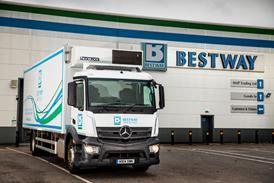
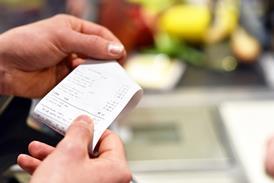
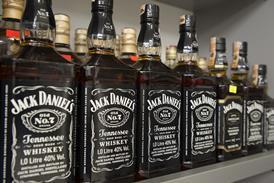

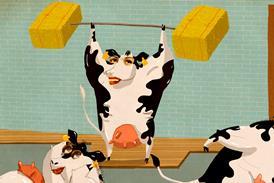

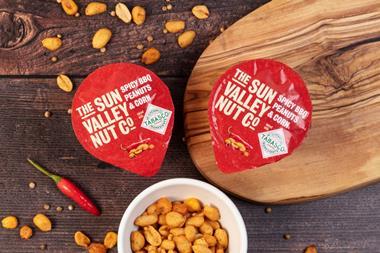
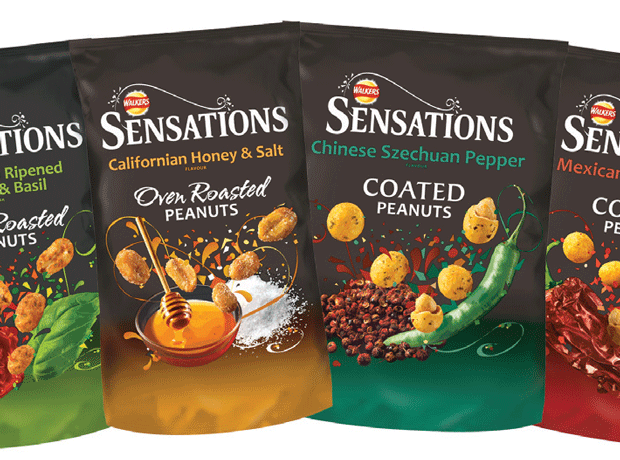
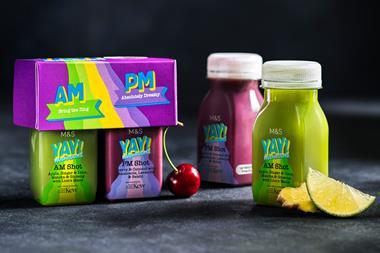
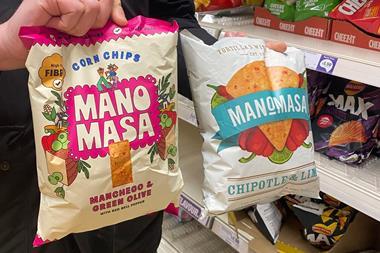
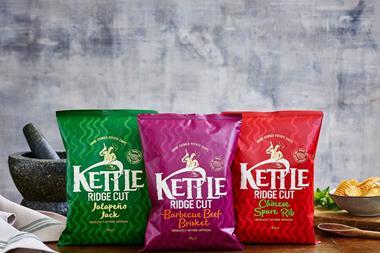




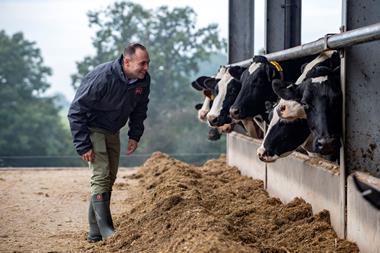


No comments yet